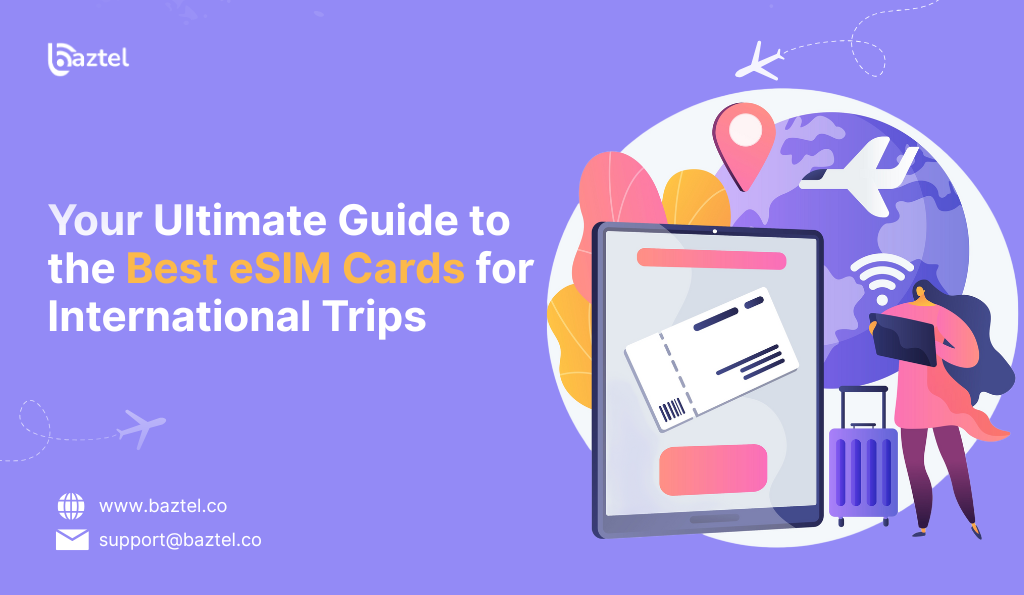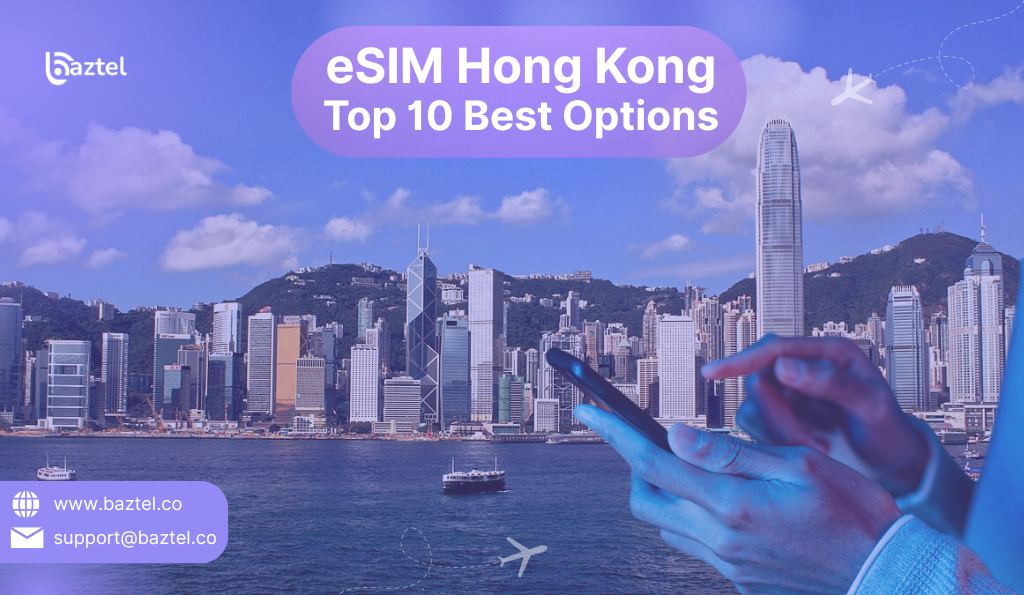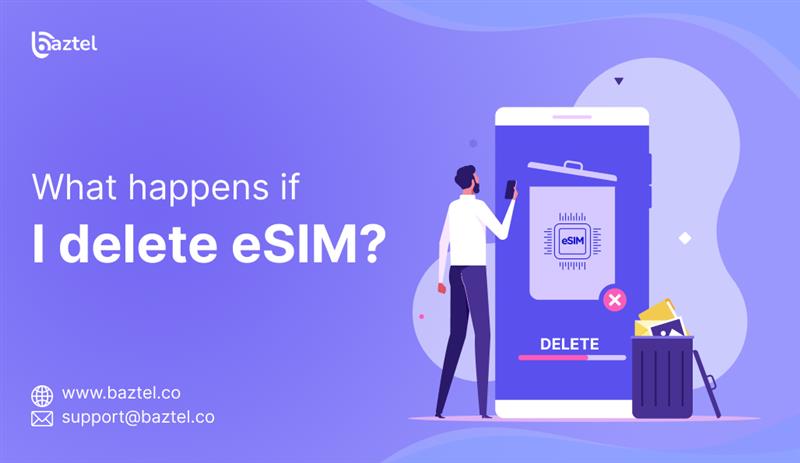If you’ve ever searched for a local SIM at the airport or paid high roaming charges, you’re not alone. Traveling should be fun—not stressful because of mobile data issues.
That’s where eSIMs come in. They’re the modern way to stay connected while traveling. No more tiny plastic cards. No more wasting time. Just fast, easy internet wherever you go.
In this guide, we will discuss everything you need to know about the best eSIMs for global travel, how to use them, why they’re better than regular SIMS and how to get the best eSIM for all of your trips.
Whether you are traveling for vacation, working remotely abroad, or just exploring the world, this guide will help you stay connected without the headaches!
How eSIMs Work
An eSIM (or embedded SIM) is a tiny chip that’s actually embedded within your phone. Unlike standard SIM cards, you never have to insert or take anything out. It all happens digitally, which is great for travelers.
Here’s how it works, step by step:
1. Built Into Your Phone
Newer phones (such as iPhones XS and later, most Samsung Galaxy phones, and Google Pixels) have an eSIM chip already installed.
This chip functions exactly like an ordinary SIM card, but you won’t need to handle it—it will remain in your phone for good and can be loaded with various mobile plans.
2. Purchase a Mobile Plan
Rather than visiting a shop to purchase a physical SIM card, you can purchase a data plan online from an app or website (such as Airalo, Holafly, or Nomad).
You get a QR code or a simple code you enter into your phone after you’ve purchased. This loads the mobile plan directly onto your eSIM.
3. Activate in Minutes
When the plan has been installed, activation is straightforward. You simply follow the instructions presented on your phone’s settings.
Most of the time, you’ll be on the local mobile network within a couple of minutes. No queuing, forms to fill in, or ID presentation like you would at a shop.
Also Read – How Long Does It Take to Activate eSIM?
4. Use Multiple Plans at Once
One of the advantages of eSIMs is that many handsets enable you to use both your standard SIM and an eSIM simultaneously.
This allows you to:
- Keep using your own number for calls or messages
- Use your eSIM for lower-cost international data on the road.
It’s the best of both worlds!
5. Switch Plans Easily
Traveling from one country to another? Don’t need to switch out SIM cards.
You can have multiple eSIM profiles on your phone and switch among them whenever desired.
Simply go to your phone settings, select the plan that you want to use, and voilà, you are ready. It’s like having multiple SIM cards in your phone without the bulk.
eSIM vs Physical SIM: Which One is Better for Travel?
An eSIM is easy to use while traveling. Each of an eSIM and a physical SIM, will allow you to stay connected while you are traveling. The key is how an eSIM works compared to a physical SIM. Let’s look at the two so you can decide what is best for you. First, let’s look at a basic comparison of the two.
1. Convenience
- eSIM: You can purchase and activate that plan before you even leave your own house!
- Physical SIM: Ideally, you need to search out a local seller (often a store or kiosk) and then buy a local SIM card. This can often take time, especially if you arrive late or you do not speak the language.
2. Setup Time
- eSIM: The setup is fast. You will either scan a QR code or input the code into your phone’s settings and you will be good to go.
- Physical SIM: You will need to remove your current sim card, insert your new sim card, and usually restart your phone. In addition to the normal steps, you may often have to update settings.
3. Dual SIM Functionality
- eSIM: Most phones let you have both an eSIM and your physical SIM. So you can have your usual number and use a travel data plan.
- Physical SIM: When a phone supports dual SIM (dual-SIM), it means you can use two physical SIMs, but very few phones provide this option.
4. Availability and Compatibility
- eSIM: Not every phone currently supports eSIM. If you have an older or budget phone, then by default, it may not support eSIM. Additionally, not every country or carrier supports eSIM plans.
- Physical SIM: You can use a physical SIM almost everywhere in the world, and physical SIMs can be purchased in almost every country.
5. Flexibility
- eSIM: You can have as many eSIM plans as you can fit, and switching between eSIMs is seamless—excellent for travel across multiple countries.
- Physical SIM: You need to physically carry and change SIM cards if you’re visiting multiple countries.
6. Risk of Loss or Damage
- eSIM: Since it’s built into your phone, you can’t lose it or break it.
- Physical SIM: Easy to misplace, damage, or even forget to bring a SIM ejector tool!
For most modern travelers, eSIMs are a better option because they are faster to set up, easier to manage, and more flexible.
That said, if your phone does not support eSIM or you are going to a place where eSIM plans do not exist, a physical SIM will still serve its purpose.
Benefits of Using eSIMs While Traveling
eSIMs provide modern, stable connectivity, unlike a traditional SIM card. Let’s examine 5 reasons why eSIM is better for international travelers:
1. Seamless Activation Before or During Travel
eSIMs can be purchased online and activated online and are usually activated instantaneously. This allows travelers to configure their mobile plan prior to leaving home or when they arrive in the destination country—no hunting for a local SIM vendor service or wasting time waiting in line. You will have internet connectivity when you deplane; this immediately helps you find your accommodations, book rides and contact loved ones.
2. No Physical Handling or SIM Swapping
An eSIM is multi-accessible through the device, as opposed to being physical in nature (SIM cards require physical insertion), meaning you will not touch it! You don’t have to worry about losing the SIM card or damaging your SIM, especially when you are traveling across multiple countries. You do not need to carry with you SIM ejector tools nor have to keep track of small plastic tray pieces.
3. Use Two Networks at the Same Time
Most phones that have eSIM capabilities also allow the use of two SIMs, so you can keep your regular SIM in service for calls and texts and use your eSIM for local or international data. This refers to when you want the ability to stay connected with people back home, using inexpensive data plans in the country or area you are traveling, and without having to carry two phones or continually edit your settings.
4. Access to Cost-Effective Global and Regional Plans
Most eSIM providers sell prepaid data plans at much lower prices than international roaming charges presented to you by your home carrier. The plans can be global, regional or country ownership and priced in a way that fits your travel budget and length of travel. Essentially, these plans can help a traveler avoid additional hidden fees that they may encounter with their home carrier while also giving the traveler the ability to control their costs for connectivity.
Also Read – Best eSIM for International Travel of 2025
5. Fast and Flexible Switching Between Countries
For trips that may involve multiple countries, eSIMs allow flexibility like no other. A traveler never has to remove or replace their SIMs and can preload multiple eSIM profiles or also purchase plans on a go-forward basis. There is no need to swap out a physical SIM, reset your phone, or experience service interruptions by major bio-contingencies. Switching between plans is an easy process that simply requires you to tap a few buttons in your phone’s settings.
How to Choose the Right eSIM for Your Trip
Choosing the right eSIM isn’t just about choosing the cheapest plan; it is also about choosing one that meets your Travel destination, Travel duration, data usage and Mobile device. To navigate through the options, here are five key factors to consider before selecting the best eSIM cards for international travel:
Check Coverage in Your Destination
The first and most crucial step is to ensure that the eSIM provider has reliable coverage in the country- or countries- you will be traveling to. Some eSIMs will work globally, while others will focus on Europe, Asia or North America. But “coverage” is about more than just availability; it is also about quality.
Seek out eSIMs that link to well-established local carriers in your destination. This provides quicker speeds, improved stability, and fewer dead zones. Most providers publish their local carrier partners online—study this in-depth before buying.
Understand Your Data Usage
Prior to purchasing a plan, guess at how much data you’ll actually consume. Light users who use Wi-Fi mostly might be content with 1–3 GB per week. If you’re going to stream music, take Zoom calls, post photos, or frequently use Google Maps to navigate, though, you’ll need much more.
Most of the top eSIM cards for global travel offer multiple data plans, from simple to unlimited. The key is selecting an appropriate data plan to avoid purchasing additional top-ups—or wasting money on unused data.
Compare Price and Validity Periods
Not all eSIM plans are equal in terms of cost and duration. Some are cheap but only last for a few days, while others last for a whole month or more.
For a direct comparison between plans, look at the price per GB, but also look at how many days the validity window lasts for; a 30-day plan is a better deal than a 7-day plan, depending on how long you are on your trip. You want to ensure that the plan matches the time you need to travel for and also that it provides flexibility if your plans change.
Verify Device Compatibility
eSIMs will only work on compatible devices, and not all phones are compatible. Furthermore, even supported devices may have region-lock or firmware-related issues that prevent enablement.
Almost always a safe bet prior to making your purchase is to check the device you’re using with the plan on your provider’s web page for your device model and carrier. Most popular brands like Apple, Samsung, or Google most recently had eSIM support on new devices, but it’s always worth checking! If your phone is unable to use the best plan you purchased, it’s irrelevant anyway.
Evaluate Ease of Use and Customer Support
When technology aspects go wrong, specifically when you are traveling, it can be troublesome. Therefore, you want to find a good eSIM provider; they should have established themselves as a provider with a reputed mantle for being user-friendly to set up and provide a decent customer service experience.
When selecting an eSIM provider to avoid a headache when traveling internationally, look for a provider with step-by-step installation instructions (QR codes at least!), a mobile application to monitor your data usage, and a support team you can reach out to via chat the email/ web submission. This is especially useful if you’re traveling in a totally different time zone or you’re in a completely different culture.
In finding the best eSIM cards for international travel, you should be considering cost, convenience, and connectivity. If you research a little on coverage, data needs, device compatibility, and service to help you not stress while abroad and help keep you connected!
Tips for Using eSIMs Abroad
eSIMs provide an easy and hassle-free method of staying connected when abroad. But to ensure you maximize their benefits, it is a good idea to adopt some smart tips. These best practices will save you time, money, and data regardless of which of the top eSIM cards for international travel you have.
1. Download and Activate Your eSIM Before You Leave
One of the biggest blunders travelers make is to install their eSIM after arriving at their destination. Airports may not provide great Wi-Fi, so while you’re traveling, you may not be able to access your email, QR code, or provider’s app when you land.
Instead, install and activate your eSIM while you’re still at home and connected to Wi-Fi. You will have time to troubleshoot any issues in a calm environment and will have your data plan ready to go when you land—perfect for booking a ride, getting to your hotel, or checking in with loved ones.
2. Understand the Validity Period and Data Limits of Your Plan
eSIM data plans usually have a fixed period (7, 15, or 30 days) and typically have a fixed amount of data. Take the time to read the plan details and understand when your plan starts, when it ends, and how much data you are allowed to consume.
3. Turn On Data Roaming for the eSIM Line
While the term “data roaming” is often associated with burdensome costs, it is a requirement for the eSIMs to successfully work while traveling, but only for the eSIM line and not your home SIM. Roaming allows the phone to connect to the local network that has partnered with the eSIM provider in the destination country.
This environment does not activate charges from your usual carrier, provided they are not using your main SIM to access mobile data. Make sure that your main SIM is not used for mobile data. Check your phone’s cellular options and make sure the eSIM line is activated, data is enabled, and roaming for that line alone is allowed.
4. Use Wi-Fi When Available to Conserve Mobile Data
No matter which eSIM card for global travel you have chosen, mobile data is a limited resource, especially if on a capped plan. Using Wi-Fi as often as you can at your hotel, at cafés, at airports, or any public Wi-Fi that you can find will go a long way to limiting your mobile data consumption.
Limit your eSIM data usage by using it for times when you really need it: for getting around lost streets, for booking transportation, or for using translation apps on the go! For heavier tasks like uploading images, watching videos, or making video meetings, set the expectation of waiting until you find reliable Wi-Fi. This practice will not only allow for conservation of your data, but it will also offer the smoothest experience while not being on Wi-Fi.
5. Keep Your eSIM Profile for Future Trips
After your trip, unless your provider specifically says to do so, don’t delete your eSIM from your phone. Most eSIM providers allow you to reuse the same profile simply by purchasing a new plan for your next trip.
Depending on your provider, having the profile saved can save you setup time in the future and often allows for faster reactivation/turnup. Some apps also carry your previous travel history and preferences to help you in planning your next trip. This is especially useful when you are in the region often or want to stick with a few providers you have already used.
Conclusion: Travel Smarter with the Best eSIM Cards for International Travel
As travel becomes increasingly digital and borderless, staying connected should be easy—not expensive or complicated. That’s exactly what eSIM technology is all about. Whether you are traveling for a long weekend, on a business trip, or on a months-long journey, using an eSIM will save you time, money and the stress of getting connectivity.
The best eSIM cards for international travel offer instant provisioning, flexible data packages, and easy switching between countries—all while eliminating the love-hate relationship with tiny SIM cards and going to local mobile shops. With an eSIM and the proper plan in place, you can land in any country with everything set up to navigate, communicate and explore—totally connected from the start.
But before your next trip, take some time to compare providers, know your data needs, and check your mobile device compatibility. A small amount of effort up front will allow you to have a connected adventure, no matter where you end up!
Blog Author
Peter
Peter started BazTel.co to make mobile internet easier for travellers. He noticed how tough it was to find good network options while visiting new countries. That’s when he built BazTel — a place where anyone can buy eSIMs online without confusion or long steps. He believes tech should be simple and useful, not complicated. When he’s free, he likes to travel, test BazTel himself, and keep improving it based on real user problems.

 Botswana
Botswana Zambia
Zambia Congo
Congo Colombia
Colombia China mainland
China mainland Chile
Chile Chad
Chad Central African Republic
Central African Republic Canada
Canada Cameroon
Cameroon Cambodia
Cambodia Burkina Faso
Burkina Faso Bulgaria
Bulgaria Brunei Darussalam
Brunei Darussalam Brazil
Brazil Aland Islands
Aland Islands Bosnia and Herzegovina
Bosnia and Herzegovina Bolivia
Bolivia Belgium
Belgium Belarus
Belarus Bangladesh
Bangladesh Bahrain
Bahrain Azerbaijan
Azerbaijan Austria
Austria Australia
Australia Armenia
Armenia Argentina
Argentina Algeria
Algeria



